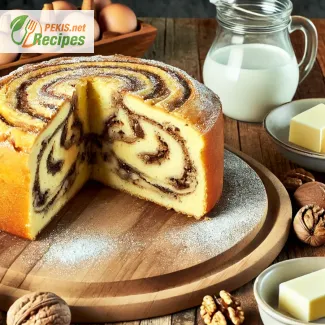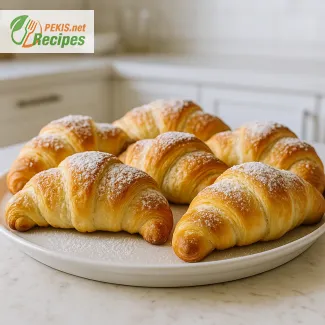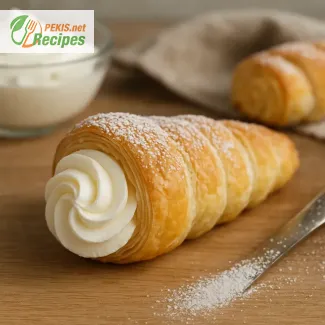
Marble Potica, a staple of Slovenian culinary heritage, is a uniquely layered dessert bread that beautifully blends flavors and textures to symbolize family gatherings and festive joy. Traditionally baked during holidays like Christmas and Easter, marble potica stands out for its distinctive swirled layers of light dough and rich fillings, often walnut or chocolate. Each layer tells a story of craftsmanship and cultural pride, making this potica not only a delightful indulgence but also a piece of Slovenian identity on the table.
What Marble Potica is Used For
Marble potica has long been cherished in Slovenia as a special holiday delicacy, central to celebrations and family feasts. Its impressive appearance and luscious texture make it an ideal choice for gatherings where warmth and hospitality are celebrated. While primarily a dessert, marble potica is versatile, pairing well with coffee or tea and even as a treat for brunch, elevating everyday moments into memorable experiences. Beyond holidays, it’s now commonly enjoyed at weddings, birthdays, and cultural festivals as a symbol of Slovenian hospitality.
Types of Marble Potica
Marble potica has a few popular variations, each reflecting different tastes and traditions:
- Walnut Marble Potica
This is the most traditional variety, where ground walnuts create the darker swirl, adding a slightly earthy taste that complements the sweet dough. Walnuts also add a subtle crunch, enhancing the overall texture. - Chocolate Marble Potica
For those with a sweet tooth, chocolate marble potica is a modern favorite, where the dark swirl features rich cocoa or melted chocolate. This version balances the nutty sweetness of the dough with a deep chocolate taste, making it especially popular among younger generations. - Hazelnut Marble Potica
Similar to the walnut version, hazelnut marble potica brings a sweeter, nuttier profile. The hazelnuts’ milder flavor combines wonderfully with the dough, adding a unique richness that’s both delicate and satisfying. - Honey-Cinnamon Marble Potica
For a spiced twist, this type of potica uses cinnamon and honey as the base for the filling, offering an aromatic, warm flavor perfect for cold winter months. This version is lighter and may be preferred by those who enjoy spiced desserts.
Why Marble Potica is So Special
Marble potica’s beautiful swirls are not only visually captivating but also representative of the Slovenian art of baking. Creating these swirls requires skill and patience, as the dough and filling must be layered and rolled with precision to achieve the perfect marbling effect. Every slice reveals a unique pattern, making each cut a small masterpiece that celebrates the baker’s dedication and the care put into the preparation.
Potica’s symbolic nature comes from its role in Slovenian tradition. Generations of Slovenian families have shared this dessert during holidays, passing down the recipe and the story behind it. It is more than a dessert; it is a way of honoring heritage and a symbol of togetherness. Even as modern variations emerge, marble potica remains a testament to Slovenian pride, keeping families connected to their cultural roots.
Culinary Tips for Marble Potica
To bring out the best in marble potica, use high-quality ingredients. Fresh, local nuts add an authentic flavor, while real butter and eggs provide a rich, tender crumb. Allowing the dough to rise properly ensures a light, airy texture that beautifully contrasts the rich filling. A sprinkle of powdered sugar after baking enhances its festive look, while careful slicing reveals the stunning marbled pattern inside, making it as visually impressive as it is delicious.
Marble potica, with its unique, marbled elegance and history-laden flavors, continues to be more than a dessert—it's a celebration of Slovenian heritage and a holiday favorite that brings joy and warmth to any gathering.
Dough Preparation:
- Prepare the yeast: Warm the milk (not hot), add a teaspoon of sugar, and stir in the yeast. Let sit for 10–15 minutes until frothy.
- Make the dough: In a large bowl, combine flour, sugar, salt, and lemon zest. Add the yeast mixture and egg, then mix. Gradually add melted butter and knead until smooth (about 10 minutes).
- First rise: Shape the dough into a ball, cover with a cloth, and let rise for about 1 hour, until doubled.
Filling Preparation:
- Prepare the filling: In a saucepan, warm the milk, then add butter, sugar, and cocoa. Stir until smooth, then add ground walnuts and vanilla sugar. Allow to cool slightly before adding the egg.
Assembling the Potica:
- Roll the dough: On a floured surface, roll the dough into a rectangle about 40x30 cm (15.7x11.8 in).
- Spread filling: Evenly spread the walnut filling over the dough, leaving a small border.
- Roll up: Carefully roll the dough into a log, tucking the edges. Place in a greased baking pan, seam side down, and let rise for 30 minutes.
Baking:
- Preheat and bake: Preheat the oven to 180°C (350°F). Brush the potica with beaten egg and bake for 50–60 minutes until golden brown.
- Cool: Allow to cool slightly before slicing.
Marble Potica, enjoyed in moderation, brings a taste of Slovenian tradition to any special occasion.
Marble Potica is a rich source of calories and macronutrients, providing the body with carbohydrates from flour and sugar, which are essential for quick energy. The walnut filling contributes healthy fats, primarily unsaturated, that support heart health by helping manage cholesterol levels. Proteins from eggs and walnuts aid in muscle repair and immune function.
Key Vitamins and Their Benefits:
- Vitamin B1 (Thiamine): Found in flour, it supports energy metabolism and nervous system health.
- Vitamin B2 (Riboflavin): From eggs, aiding cellular energy production.
- Vitamin E: Abundant in walnuts, acts as a powerful antioxidant, protecting cells from damage and promoting skin health.
Mineral Benefits:
- Magnesium: Present in walnuts, it assists with muscle relaxation and stress reduction.
- Calcium: Sourced from milk and butter, essential for bone and teeth health.
Dietary Fiber
The walnuts provide fiber, crucial for digestive health and blood sugar regulation, while also promoting satiety.
Health Considerations
Due to high sugar and fat content, marble potica should be consumed in moderation. Adjusting ingredients, such as reducing sugar or replacing butter with healthier fats, can make it more suitable for regular consumption without compromising enjoyment.
Marble Potica is best enjoyed as an occasional treat, ideally on holidays or special occasions. Due to its high-calorie and sugar content, it’s not suited for regular consumption. Instead, savoring it once a month or during family gatherings helps maintain balance in the diet while still celebrating tradition.
Tips:
- Portion Control: Serve in small slices to appreciate the flavors without overindulging.
- Ingredient Adjustments: Try reducing sugar or substituting with honey for a lighter option, or add dried fruit to enhance natural sweetness.
This recipe contains gluten (flour), lactose (butter, milk), tree nuts (walnuts), and eggs.
Substitution Tips for Allergies
- Gluten-free: Use gluten-free flour and add a binder like xanthan gum to improve texture.
- Lactose-free: Replace milk with almond or soy milk and butter with lactose-free margarine.
- Nut-free: Substitute walnuts with sunflower or pumpkin seeds.
- Egg-free: Replace each egg with a flaxseed mix (1 tbsp ground flaxseed + 3 tbsp water) for binding.





